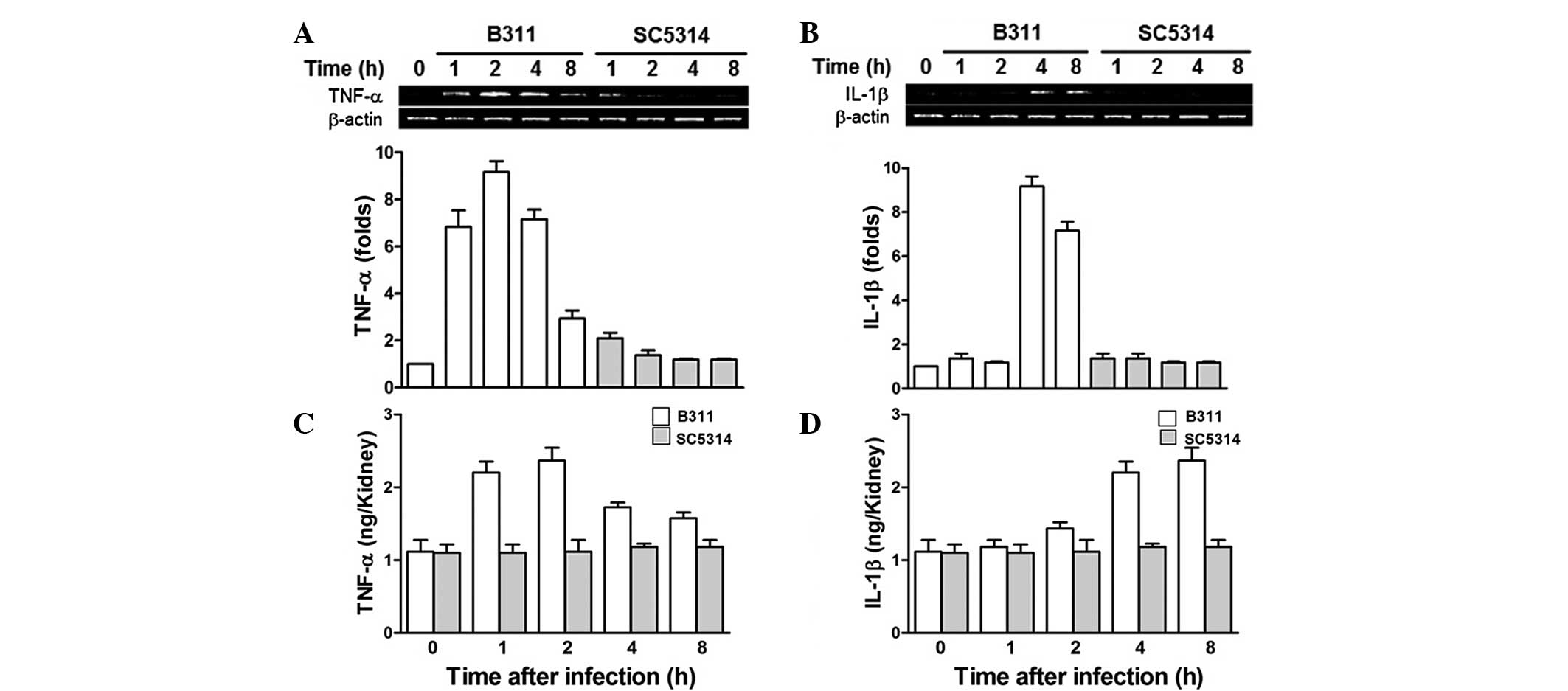|
1
|
Kim J and Sudbery P: Candida albicans, a
major human fungal pathogen. J Microbiol. 49:171–177. 2011.
View Article : Google Scholar : PubMed/NCBI
|
|
2
|
Arulanantham K, Dwyer JM and Genel M:
Evidence for defective immunoregulation in the syndrome of familial
candidiasis endocrinopathy. N Engl J Med. 300:164–168. 1979.
View Article : Google Scholar : PubMed/NCBI
|
|
3
|
Netea MG, Van Der Graaf CA, Vonk AG,
Verschueren I, Van Der Meer JW and Kullberg BJ: The role of
toll-like receptor (TLR) 2 and TLR4 in the host defense against
disseminated candidiasis. J Infect Dis. 185:1483–1489. 2002.
View Article : Google Scholar : PubMed/NCBI
|
|
4
|
Vonk AG, Netea MG, van Krieken JH, van der
Meer JW and Kullberg BJ: Delayed clearance of intraabdominal
abscesses caused by Candida albicans in tumor necrosis
factor-alpha- and lymphotoxin-alpha-deficient mice. J Infect Dis.
186:1815–1822. 2002. View
Article : Google Scholar : PubMed/NCBI
|
|
5
|
Davis D, Edwards JE Jr, Mitchell AP and
Ibrahim AS: Candida albicans RIM101 pH response pathway is required
for host-pathogen interactions. Infect Immun. 68:5953–5959. 2000.
View Article : Google Scholar : PubMed/NCBI
|
|
6
|
Brieland J, Essig D, Jackson C, et al:
Comparison of pathogenesis and host immune responses to Candida
glabrata and Candida albicans in systemically infected
immunocompetent mice. Infect Immun. 69:5046–5055. 2001. View Article : Google Scholar : PubMed/NCBI
|
|
7
|
Clemons KV and Stevens DA: Efficacy of the
partricin derivative SPA-S-753 against systemic murine candidosis.
J Antimicrob Chemother. 47:183–186. 2001. View Article : Google Scholar : PubMed/NCBI
|
|
8
|
Graybill JR, Bocanegra R, Najvar LK,
Hernandez S and Larsen RA: Addition of caspofungin to fluconazole
does not improve outcome in murine candidiasis. Antimicrob Agents
Chemother. 47:2373–2375. 2003. View Article : Google Scholar : PubMed/NCBI
|
|
9
|
Kumamoto CA and Vinces MD: Contributions
of hyphae and hypha-co-regulated genes to Candida albicans
virulence. Cell Microbiol. 7:1546–1554. 2005. View Article : Google Scholar : PubMed/NCBI
|
|
10
|
Niewerth M and Korting HC: Phospholipases
of Candida albicans. Mycoses. 44:361–367. 2001. View Article : Google Scholar : PubMed/NCBI
|
|
11
|
Schaller M, Borelli C, Korting HC and Hube
B: Hydrolytic enzymes as virulence factors of Candida albicans.
Mycoses. 48:365–377. 2005. View Article : Google Scholar : PubMed/NCBI
|
|
12
|
Yang YL: Virulence factors of Candida
species. J Microbiol Immunol Infect. 36:223–228. 2003.PubMed/NCBI
|
|
13
|
Parker JC Jr, McCloskey JJ and Knauer KA:
Pathobiologic features of human candidiasis. A common deep mycosis
of the brain, heart and kidney in the altered host. Am J Clin
Pathol. 65:991–1000. 1976.PubMed/NCBI
|
|
14
|
Spellberg B, Ibrahim AS, Edwards J Jr and
Filler SG: Mice with disseminated candidiasis die of progressive
sepsis. J Infect Dis. 192:336–343. 2005. View Article : Google Scholar : PubMed/NCBI
|
|
15
|
Schindler R, Krautzig S, Lufft V, et al:
Induction of interleukin-1 and interleukin-1 receptor antagonist
during contaminated in-vitro dialysis with whole blood. Nephrol
Dial Transplant. 11:101–108. 1996. View Article : Google Scholar : PubMed/NCBI
|
|
16
|
Descamps-Latscha B, Herbelin A, Nguyen AT,
et al: Balance between IL-1 beta, TNF-alpha, and their specific
inhibitors in chronic renal failure and maintenance dialysis.
Relationships with activation markers of T cells, B cells, and
monocytes. J Immunol. 154:882–892. 1995.PubMed/NCBI
|
|
17
|
O'Day DM, Head WS, Csank C, et al:
Differences in virulence between two Candida albicans strains in
experimental keratitis. Invest Ophthalmol Vis Sci. 41:1116–1121.
2000.PubMed/NCBI
|
|
18
|
O'Day DM, Head WS, Robinson RD, Yang R,
Shetlar D and Wang MX: Contact lens-induced infection - a new model
of Candida albicans keratitis. Invest Ophthalmol Vis Sci.
40:1607–1611. 1999.PubMed/NCBI
|
|
19
|
Odds FC, Brown AJ and Gow NA: Candida
albicans genome sequence: a platform for genomics in the absence of
genetics. Genome Biol. 5:2302004. View Article : Google Scholar : PubMed/NCBI
|
|
20
|
O'Day DM, Robinson R and Head WS: Efficacy
of antifungal agents in the cornea. I. A comparative study. Invest
Ophthalmol Vis Sci. 24:1098–1102. 1983.PubMed/NCBI
|
|
21
|
Leunk RD and Moon RJ: Physiological and
metabolic alterations accompanying systemic candidiasis in mice.
Infect Immun. 26:1035–1041. 1979.PubMed/NCBI
|
|
22
|
Hoyer LL, Clevenger J, Hecht JE, Ehrhart
EJ and Poulet FM: Detection of Als proteins on the cell wall of
Candida albicans in murine tissues. Infect Immun. 67:4251–4255.
1999.PubMed/NCBI
|












